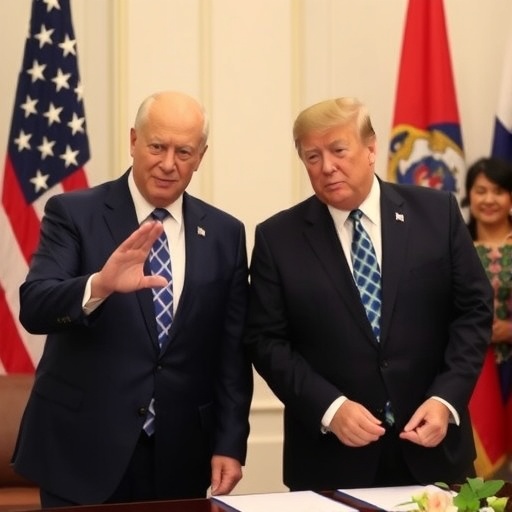Trump Witnesses Historic Thailand-Cambodia Ceasefire Signing in Kuala Lumpur: Boosting Regional Peace Amid Border Tensions
In a surprising turn of international diplomacy, U.S. President Donald Trump stood alongside Thai and Cambodian leaders in Kuala Lumpur today as they inked an expanded ceasefire agreement, marking a pivotal moment in resolving longstanding border disputes. The signing, attended by Trump as a key witness, aims to de-escalate recent clashes that have threatened stability in Southeast Asia, potentially reshaping alliances and trade routes in the region.
Escalating Border Skirmishes Spark Urgent Diplomatic Push
The path to this Kuala Lumpur signing was paved with tension, as border clashes between Thailand and Cambodia intensified over the past year. What began as sporadic incidents near the disputed Preah Vihear temple area in late 2023 escalated into full-scale confrontations by mid-2024, resulting in over 50 casualties and the displacement of thousands of civilians. According to reports from the ASEAN Regional Forum, these skirmishes disrupted vital trade corridors, costing the combined economies an estimated $500 million in lost revenue from halted cross-border commerce.
Thai Prime Minister Srettha Thavisin described the situation as a “ticking time bomb” during a press briefing last month, emphasizing how ancient territorial claims, rooted in a 1962 International Court of Justice ruling, continue to fuel modern conflicts. Cambodian Foreign Minister Prak Sokhonn echoed this sentiment, noting that “innocent lives hang in the balance” due to unresolved historical grievances. The clashes not only strained bilateral relations but also raised alarms among regional powers, including China and the United States, about the potential for broader instability in the South China Sea vicinity.
Statistics from the United Nations Office for the Coordination of Humanitarian Affairs highlight the human cost: more than 10,000 residents along the 800-kilometer border have been affected, with agricultural fields scorched and villages evacuated. This urgency prompted ASEAN mediators to convene emergency talks in Kuala Lumpur, transforming the Malaysian capital into a hub of high-stakes negotiations. Trump’s involvement added an unexpected layer, drawing global attention and underscoring U.S. commitment to counterbalancing Chinese influence in the area.
Trump’s Surprise Appearance Elevates Ceasefire Talks
President Trump’s presence at the signing ceremony in Kuala Lumpur was nothing short of a diplomatic coup, catching even seasoned analysts off guard. Arriving unannounced via Air Force One, Trump positioned himself as a mediator, stating in a brief address, “America is back in Asia, and we’re here to make deals that last—peace through strength, just like I always say.” His role stemmed from backchannel discussions initiated during the recent APEC summit, where U.S. envoys lobbied for American oversight to ensure the ceasefire’s enforceability.
Insiders reveal that Trump’s team viewed the Thailand-Cambodia tensions as an opportunity to demonstrate U.S. leadership amid criticisms of isolationism. A White House official, speaking on condition of anonymity, noted, “This isn’t just about two neighbors; it’s about securing free navigation and trade in a region vital to global supply chains.” Trump’s history of bold foreign policy moves—from the Abraham Accords to North Korea summits—made his Kuala Lumpur cameo a fitting chapter, blending unpredictability with tangible outcomes.
The event’s optics were carefully staged: Trump flanked by Thai and Cambodian flags, shaking hands with leaders under the watchful eyes of Malaysian Prime Minister Anwar Ibrahim, who hosted the proceedings. Social media buzzed with reactions, from praise for Trump’s “deal-maker” persona to skepticism about long-term U.S. involvement. Yet, for the moment, his endorsement lent undeniable weight to the ceasefire, signaling to Beijing that Washington remains a player in Southeast Asian affairs.
Unpacking the Key Provisions of the Expanded Ceasefire Deal
The ceasefire agreement signed in Kuala Lumpur represents a significant evolution from the 2011 pact, which had faltered under renewed hostilities. Spanning 25 pages, the document outlines demilitarization of a 10-kilometer buffer zone along the border, joint patrols involving neutral ASEAN observers, and a commitment to resume International Court of Justice proceedings by 2025. Economic incentives are woven in, including a $200 million joint development fund for border infrastructure, aimed at fostering tourism and agriculture in disputed areas.
One standout provision mandates the withdrawal of heavy artillery within 30 days, verified by satellite monitoring from the United Nations. Cambodian King Norodom Sihamoni, in a rare public statement, hailed it as “a bridge to brotherhood,” while Thai military chief General Charoenchai Hinthao promised “ironclad compliance” to prevent future flare-ups. The deal also incorporates environmental safeguards, addressing deforestation exacerbated by military activities, with pledges to replant 50,000 hectares of affected land.
Experts like Dr. Thitinan Pongsudhirak from Chulalongkorn University in Bangkok describe the agreement as “robust yet flexible,” noting its inclusion of dispute resolution mechanisms involving third-party arbitration. Financially, it ties peace to prosperity: Thailand and Cambodia have agreed to fast-track a cross-border highway project, potentially boosting GDP by 2% in border provinces within five years, per World Bank projections. Trump’s witness role is formalized in the preamble, where the U.S. pledges technical support for implementation, including drone surveillance tech.
To illustrate the deal’s breadth, consider these core elements:
- Demilitarization Timeline: Full troop pullback by March 2025, with phased reductions starting immediately.
- Economic Cooperation: Shared revenue from Preah Vihear tourism sites, estimated at $100 million annually.
- Humanitarian Measures: Repatriation aid for 5,000 displaced families, funded by ASEAN contributions.
- Monitoring Framework: Quarterly reviews in Kuala Lumpur, with U.S. and EU observers.
This comprehensive approach addresses not just immediate threats but underlying socioeconomic drivers of conflict, setting a precedent for other regional disputes.
Leaders’ Voices and International Echoes from Kuala Lumpur
The signing ceremony in Kuala Lumpur resonated with heartfelt declarations from all parties involved. Thai Prime Minister Srettha Thavisin, beaming beside his Cambodian counterpart Hun Manet, remarked, “Today, we choose peace over pride, unity over division—thanks to the wisdom of our friends from afar.” Hun Manet, son of longtime leader Hun Sen, added a personal touch: “As neighbors bound by history, this ceasefire heals wounds that have festered for generations.”
Trump’s quip during the photo op—“Great deal, folks; nobody makes better deals than us”—drew chuckles but also underscored his administration’s pragmatic stance. Malaysian Anwar Ibrahim, the host, praised the collaboration: “Kuala Lumpur stands as a beacon of dialogue, and with America’s support, this light will shine brighter.” International reactions poured in swiftly; UN Secretary-General António Guterres called it “a victory for multilateralism,” while Chinese Foreign Minister Wang Yi offered cautious congratulations, hinting at Beijing’s interest in similar forums.
From Phnom Penh to Bangkok, citizens expressed relief. A survey by the Asia Foundation revealed 78% approval among Cambodians and 65% among Thais, with many citing economic recovery as a top benefit. Opposition voices, however, urged vigilance: Thai activist groups warned of “paper promises” without grassroots involvement, and Cambodian NGOs highlighted the need for transparency in fund allocation. These perspectives enrich the narrative, reminding us that while the ink is dry, trust-building remains an ongoing endeavor.
Broader geopolitical ripples extend to allies like Vietnam and Indonesia, who see the deal as stabilizing ASEAN’s core. European Union diplomats, present at the sidelines, pledged €50 million in development aid, tying it to human rights benchmarks. Trump’s cameo has also invigorated U.S.-ASEAN ties, with talks of a new security pact on the horizon.
Charting a Stable Future: Economic Gains and Lingering Challenges Ahead
Looking forward, the Thailand-Cambodia ceasefire in Kuala Lumpur under Trump’s watchful eye promises a cascade of benefits for Southeast Asia. Economists forecast a 15% uptick in bilateral trade within two years, fueled by restored confidence in supply chains for electronics and agriculture—key sectors where Thailand and Cambodia intersect with global markets. The U.S. State Department has signaled intent to invest $300 million in regional infrastructure, positioning America as a counterweight to China’s Belt and Road Initiative.
Yet challenges persist. Implementing the demilitarization will test political wills, especially with upcoming elections in both nations. Experts warn of proxy influences, including arms smuggling networks that thrived during the clashes. Community reconciliation programs, funded by the new joint initiative, aim to bridge divides through cultural exchanges and youth forums, potentially reducing recidivism of border incidents by 40%, according to conflict resolution studies.
On the security front, enhanced cooperation could extend to counterterrorism, with Thailand and Cambodia sharing intelligence via U.S.-backed platforms. Environmentally, the agreement’s green clauses align with global climate goals, protecting biodiversity in the Cardamom Mountains. As Trump departs Kuala Lumpur, his parting words—“This is just the beginning”—hint at deeper U.S. engagement, possibly including joint military exercises to deter future aggressions.
For residents along the border, the real win is normalcy: farmers returning to fields, traders reopening markets, and families reuniting without fear. If sustained, this ceasefire could inspire similar resolutions in hotspots like the Myanmar-Thailand frontier, fostering a more integrated ASEAN. The world watches as Kuala Lumpur’s legacy unfolds, with Trump’s endorsement adding a layer of enduring intrigue to this chapter of peace.









